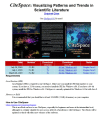Exploring the Emerging Evolution Trends of Urban Resilience Research by Scientometric Analysis
- PMID: 30301209
- PMCID: PMC6210392
- DOI: 10.3390/ijerph15102181
Exploring the Emerging Evolution Trends of Urban Resilience Research by Scientometric Analysis
Abstract
: Numerous studies in urban resilience have been published in the past decade. However, only a few publications have tracked the evolution trends of urban resilience research, the findings of which can serve as a useful guide for scholars to foresee worth-effort research areas and make the best use of precious time and resources. In order to fill the research gap, this study performed a scientometric analysis on the evolution trends of urban resilience research using a versatile software package-CiteSpace. The scientomentric analysis focuses on distribution of lead authors and their institutions, high frequency categories and keywords, high influential journals, author contribution, and evolutionary trends based on co-author analysis, co-word analysis, co-citation analysis and cluster analysis of documents. This study discoveries that first, the U.S., England, Australia, Canada, China and Sweden are the countries that make the most significant contributions in the advancement of urban resilience research; second, the existing urban resilience research focuses primarily on environmental studies, geography and planning development; third, hot topics of the urban resilience research keep shifting from 1993 to 2016; fourth, the knowledge body of urban resilience research consists of five clusters: resilience exploratory analysis, disaster resilience, urban resilience, urban resilience practice, and social-ecological systems; last, the emerging trends in urban resilience research include defining urban resilience, adaptation model, case studies, analytical methods and urban social-ecological systems, resulting in cutting-edge research areas in urban resilience.
Keywords: CiteSpace; Web of Science (WOS); evolution trends; scientometrics; urban resilience; visualization.
Conflict of interest statement
The authors declare no conflict of financial interest in CiteSpace software.
Figures









Similar articles
-
A Scientometric Review of Urban Disaster Resilience Research.Int J Environ Res Public Health. 2021 Apr 1;18(7):3677. doi: 10.3390/ijerph18073677. Int J Environ Res Public Health. 2021. PMID: 33916024 Free PMC article. Review.
-
Exploring Knowledge Domain and Emerging Trends in Climate Change and Environmental Audit: A Scientometric Review.Int J Environ Res Public Health. 2022 Mar 31;19(7):4142. doi: 10.3390/ijerph19074142. Int J Environ Res Public Health. 2022. PMID: 35409825 Free PMC article. Review.
-
Progress in urban resilience research and hotspot analysis: a global scientometric visualization analysis using CiteSpace.Environ Sci Pollut Res Int. 2022 Sep;29(42):63674-63691. doi: 10.1007/s11356-022-20138-9. Epub 2022 Apr 23. Environ Sci Pollut Res Int. 2022. PMID: 35461416 Free PMC article.
-
Emerging trends and knowledge domain of research on urban green open spaces and wellbeing: A scientometric review.Rev Environ Health. 2022 Aug 19;38(4):663-679. doi: 10.1515/reveh-2022-0091. Print 2023 Dec 15. Rev Environ Health. 2022. PMID: 35981568 Review.
-
Knowledge Domain and Emerging Trends on Echinococcosis Research: A Scientometric Analysis.Int J Environ Res Public Health. 2019 Mar 8;16(5):842. doi: 10.3390/ijerph16050842. Int J Environ Res Public Health. 2019. PMID: 30857143 Free PMC article.
Cited by
-
Evolution of Digital Health and Exploration of Patented Technologies (2017-2021): Bibliometric Analysis.Interact J Med Res. 2024 Jul 11;13:e48259. doi: 10.2196/48259. Interact J Med Res. 2024. PMID: 38991212 Free PMC article.
-
A Bibliometric and Visualization Analysis of Intermittent Fasting.Front Public Health. 2022 Jul 6;10:946795. doi: 10.3389/fpubh.2022.946795. eCollection 2022. Front Public Health. 2022. PMID: 35875030 Free PMC article.
-
Emerging Trends of Ergonomic Risk Assessment in Construction Safety Management: A Scientometric Visualization Analysis.Int J Environ Res Public Health. 2022 Dec 2;19(23):16120. doi: 10.3390/ijerph192316120. Int J Environ Res Public Health. 2022. PMID: 36498194 Free PMC article. Review.
-
Effect of operational exercises on nurses' competence in dealing with disaster.J Educ Health Promot. 2022 Feb 26;11:54. doi: 10.4103/jehp.jehp_429_21. eCollection 2022. J Educ Health Promot. 2022. PMID: 35372603 Free PMC article.
-
A scientometric analysis of global scientific literature on learning resources in higher education.Heliyon. 2023 Apr 12;9(4):e15438. doi: 10.1016/j.heliyon.2023.e15438. eCollection 2023 Apr. Heliyon. 2023. PMID: 37123982 Free PMC article.
References
-
- Holling C.S. Resilience and stability of ecological systems. Annu. Rev. Ecol. Syst. 1973;4:1–23. doi: 10.1146/annurev.es.04.110173.000245. - DOI
-
- Yu X., Zhang J. Factor analysis and psychometric evaluation of the Connor-Davidson Resilience Scale (CD-RISC) with Chinese people. Soc. Behav. Personal. Int. J. 2007;35:19–30. doi: 10.2224/sbp.2007.35.1.19. - DOI
-
- Xue X., Wang L., Yang R.J. Exploring the science of resilience: Critical review and bibliometric analysis. Nat. Hazards. 2018;90:477–510. doi: 10.1007/s11069-017-3040-y. - DOI
-
- Cascio J. Foreign Policy; 2009. [(accessed on 20 February 2017)]. The Next Big Thing: Resilience. Available online: https://foreignpolicy.com/2009/09/28/the-next-big-thing-resilience/
-
- Brown K. Global environmental change I: A social turn for resilience? Prog. Hum. Geogr. 2014;38:107–117. doi: 10.1177/0309132513498837. - DOI
Publication types
MeSH terms
LinkOut - more resources
Full Text Sources
Miscellaneous

